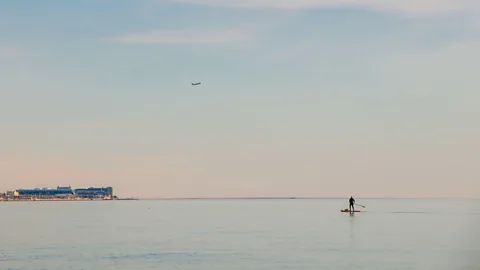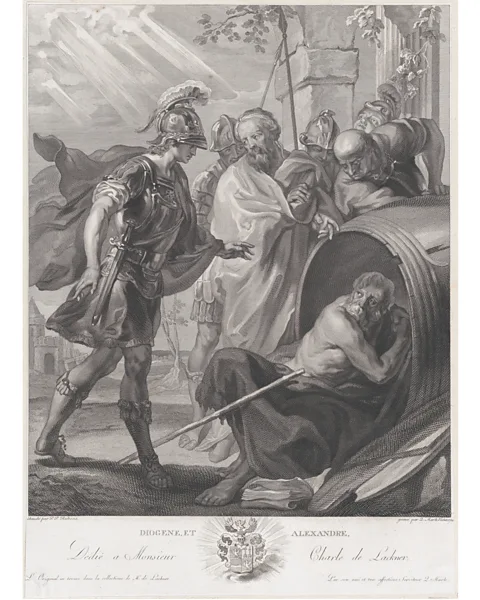Have we got minimalism all wrong?
 illustration by María Medem
illustration by María Medem'Less is more' is a familiar refrain recently – but in fact it's an idea that goes back 2,500 years. Beverley D'Silva explores outer order, inner calm – and why simplicity may help make us happy.
Minimalism seems to be everywhere these days. For something that's all about reduction and "less is more", there's an awful lot of it about. The term is now applied to innumerable philosophies, products or lifestyle choices, from a light-fitting design to the goal of owning fewer possessions or – the ultimate pared-down minimalism – monk-like asceticism. The definitions are broad. Is it a profound philosophy, intended to make us reflect on the damage we're doing to the planet, like the artist Michael Landy's 2001 seminal project Break Down, in which he destroyed all his worldly goods? Or is it just about objects – what we own and what we discard – at the level of Marie Kondo, empress of organising, whose concept of "sparking joy" through what we have around us has resonated to the tune of 11 million books sold on her Kon-Mari method.
More like this:
Kondo is part of a new army who have marched on to the popular stage in the past decade banging the minimalism drum. With her are Joshua Fields Millburn and Ryan Nicodemus, aka The Minimalists, who have made the study of material goods we own – and why – their life's work. In 2009, the boyhood friends saw the light that minimalism could shine on their stressed, high-earning executive lives, and the accumulation of possessions they it acted as a distraction from their deep unhappiness and discontent. "I was chasing the American dream," says Nicodemus, "until I realised it wasn't my dream".
 Alamy
AlamyBitten by the minimalism bug, they decluttered and jettisoned 90% of their possessions, sparking joy – and new careers – via their successful blogs, books and TV series. Their new Netflix series, Less Is Now, is an entertaining take on their personal stories and a calling to the cause, interspersed with expert insights, such as Annie Leonard of Greenpeace USA, who notes "corporations and the drive for profit are absolutely behind the addictions to stuff we have", and puts retail therapy's exponential growth down to people having "lost other ways of having a community, a purpose, an identity". Erwin McManus, founder of a "megachurch" in Los Angeles, meanwhile, has a spiritual take on it: "The lessons of minimalism are so powerful [because] we're binging on all the wrong things and dying of hunger for the things that matter," he says.
Critics point to the irony of The Minimalists' output, that it adds to the mountain of stuff – they have reached 20 million people, they say. But Millburn Fields and Nicodemus seem to genuinely believe in their mission to help "people to live meaningful lives with less". Their new book Love People, Use Things: Because the Opposite Never Works, defines their message, they say, and while decluttering is good, it's not all about having less: "We focus on making room for more – time, peace, creativity, experiences, contentment, freedom."
No wonder minimalism is a growth industry; the "stuff" mountain is getting bigger: the average US household owns 300,000 items; and additional storage space is real estate's most active growth area. Reacting against this is the "tiny house" movement; homes that are usually 40 sq m or less and are often self-built, reflecting a growing desire for reduced living costs and greater simplicity and freedom. The movement began in the US, and is gradually catching on elsewhere.
Kyle Chayka is the author of The Longing for Less: Living with Minimalism. With a background in art criticism, Chayka, who lives in New York, sees minimalism as having a deeper meaning and history than is generally recognised – one from the art world that signifies new beginnings, not necessarily a void of less. His 2020 book focuses on these origins and the 1960s cultural figures from which the movement takes its name: "Minimalism with a capital M", as he puts it. Fine artists like Donald Judd, Dan Flavin, Agnes Martin; musical composers such as John Cage, Philip Glass and Julius Eastman; and the designers, writers, architects and artists to whom the label has been applied.
"Where minimalism started in the art world was about finding beauty in unexpected things, such as in industrial materials, something that was previously ignored, and finding worth in them – not creating something that was totally blank and empty," Chayka tells BBC Culture. "Throwing out all your stuff and earning less might seem to be a rebellion against consumerism, but it also becomes an orthodoxy again [when you have to] buy the right new things and follow the right austere aesthetic."
He is unhappy about "this style some people have embraced of having just nothing and white walls and floors, it just becomes oppressive… like a new orthodoxy of total emptiness". He adds: "That concept of overlooked things is a big part of minimalism, which doesn't often happen now – it's 'Oh, I want to buy this Instagram sweater because it's minimalist'… that's not about looking at anything differently." Instagram is a big driver in minimalism's increasing popularity, he says: "The way it presents images and the blank white space is well suited to minimalist aesthetics." His next book, on "digital minimalism", will explore these ideas further.
Being and nothingness
Modern minimalism may have begun in the 20th Century, but the philosophy's roots reach far further back, some 2,500 years, and a self-determined figure called Diogenes; "the original nonconformist", according to William Stephens, professor emeritus of philosophy at Creighton University in the US. Diogenes was born around 412BC, and travelled from what is now Turkey to Athens, and, deciding he didn't need a house, lived in a felled rainwater pipe. All he possessed was a cloak, a walking stick and a leather pouch (nobody knows what he kept in it, given he had no money). Having "discovered happiness through self-mastery and self-sufficiency", Stephens says, Diogenes refused to conform to society's values of "accumulating possessions, and social status… so he was the original minimalist".
 Getty Images
Getty ImagesForward to the 3rd Century BC, and the Hellenistic philosophy of Stoicism – which is partly about the "endurance of pain or hardship without the display of feelings and without complaint" – informs a minimalistic lifestyle in its adherence to simple living ideas, accepting change, and a focus on the self and community rather than possessions. In Letters from a Stoic, Seneca wrote of "convincing yourself that you can live a happy life even without [riches], and by always regarding them as being on the point of vanishing".
Shades of Stoicism echo in Gretchen Rubin's book Outer Order, Inner Calm. An upbeat, charismatic personality, she gave her take on "what being truly happy means and how to achieve it" to Oprah Winfrey on popular US daytime series SuperSoul Sunday. Rubin tells BBC Culture that her 2019 book sprang from realising "people were feeling kind of out of control in a world in turmoil, even before the pandemic. It's natural to want to control your own environment, to manage uncertainty and anxiety. "I'd say to people, 'What makes you feel happier">window._taboola = window._taboola || []; _taboola.push({ mode: 'alternating-thumbnails-a', container: 'taboola-below-article', placement: 'Below Article', target_type: 'mix' });
